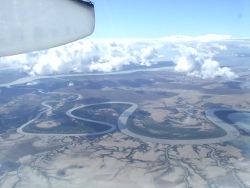|
|
Connectivity and the landscapeAquatic ecosystem connectivity refers to the connections between and within aquatic ecosystems. A good example is flooding connecting a river to a billabong. An appreciation of the connection of the wetland to other wetlands and to the broader catchment and landscape is important for effective management decisions. For example, when looking at prioritising wetlands for management actions in a catchment, a wetland that provides refuge for wildlife in a dry landscape may be given priority.
Quick facts
Walking the landscape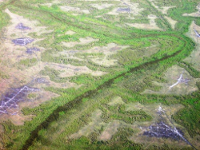
The Framework for evaluating aquatic ecosystem connectivity provides a way of understanding and applying connectivity at any level of spatial scale for any management outcome. It can also benefit research in providing a systematic method for the consideration of complex forms of ecological connectivity. A connectivity animation and narration provides a brief yet comprehensive explanation about aquatic ecosystem connectivity across the landscape. It is supported by a connectivity poster. Walking the landscape is a whole-of-system framework for understanding and mapping environmental processes and values. Developed by the Program in collaboration with other partners it systematically and transparently synthesises science by integrating existing data with expert knowledge to develop robust conceptual models which are spatially linked to real world landscapes. This process has been used to develop interactive catchment stories which demonstrate how water flows in catchments. Connectivity is generally easy to understand and can be applied to almost any part of an ecosystem, for example:
While these examples demonstrate that the concepts of connectivity are readily understood, without a way to systematically apply this understanding it becomes difficult to evaluate it in an ecologically meaningful way. In general, management decisions focus on physical patterns of connectivity. These usually address the 'connection' provided by a physical feature of the environment, e.g. corridors, stream networks etc., assuming this to be a surrogate for other types of connectivity and that these physical connections mediate other connections. It is important to understand that connectivity does not automatically happen because of a connection by a physical medium, e.g. just because water flows between two points does not mean fish will disperse between them. As such, connectivity cannot be evaluated by the use of single physical features alone, and the potential for connectivity does not necessarily mean it will be realised. To understand aquatic ecosystem connectivity it is necessary to understand the ecological processes at work in these systems as it is these processes that make it possible for parts of the system to connect. While many effective wetland management actions can be conducted at a site level, without an appreciation of the connection of the wetland to other wetlands and to the broader catchment and landscape, many site-specific actions may be of limited value. Many of the values and ecosystems ascribed to wetlands are only effective when the wetlands are part of a connected landscape network.  Aquatic ecosystem connectivity refers to the connections between and within aquatic ecosystems. An appreciation of the connection of the wetland to other wetlands and to the broader catchment and landscape is important for effective management decisions. This YouTube animation and narration helps explain key Aquatic Ecosystem Connectivity concepts in a format aimed at high school and university students. Duration 9:50 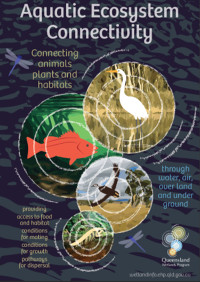 Aquatic ecosystem connectivity poster Poster promoting the importance and difference types of aquatic ecosystem connectivity The connectivity and 'Walking the landscape' frameworksThe key principles, derived from the Queensland Wetlands Program framework for evaluating aquatic ecosystem connectivity, that need to be considered when looking at connectivity, are:
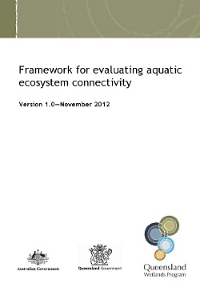 Framework for evaluating aquatic ecosystem connectivity The connectivity framework describes a process for systematically and transparently working through the connectivity of relevant functions of an aquatic ecosystem, and provides a way of understanding and applying connectivity at any level of spatial scale for any management outcome. The framework was developed through expert workshops involving policy makers and scientists from a wide range of disciplines from state, local and federal government bodies and universities. 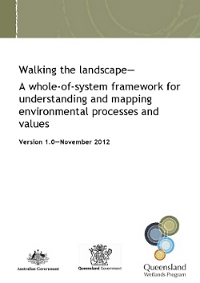 The 'Walking the landscape' framework integrates existing data with expert knowledge to develop a whole-of-system map linked to conceptual models showing how the environment functions. The method addresses one of the major criticisms of broadscale mapping—the lack of integration of knowledge from local experts into datasets used by decision makers. The method itself is quite flexible and can be applied:
Additional informationWalking the Landscape catchment stories. 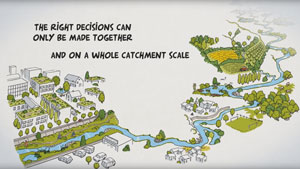 A new type of river management is coming! A short animation film on river management by the Rhone Mediterranean Corsica water Agency. The European River Restoration Community of Practice in partnership with the Environment Agency and Agence de l'eau Rhone Méditarranée Corse Duration 3m 30s Last updated: 22 March 2013 This page should be cited as: Department of Environment, Science and Innovation, Queensland (2013) Connectivity and the landscape, WetlandInfo website, accessed 8 May 2025. Available at: https://wetlandinfo.des.qld.gov.au/wetlands/ecology/components-processes-drivers/connectivity/ |

 — Department of the Environment, Tourism, Science and Innovation
— Department of the Environment, Tourism, Science and Innovation

